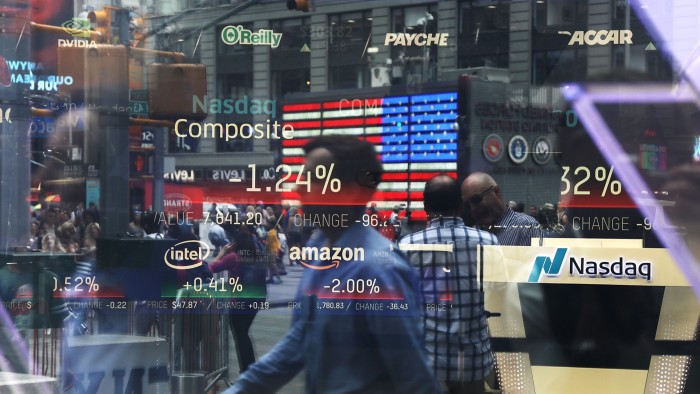Computer-driven trading firms fret over risks AI poses to their profits

Simply sign up to the Artificial intelligence myFT Digest -- delivered directly to your inbox.
Hedge funds and other computer-driven trading firms are growing increasingly concerned about the threat that artificial intelligence presents to their profits, after a fake image of an explosion near the Pentagon triggered a brief sell-off in US stocks.
The S&P 500 index fell 0.3 per cent within 30 minutes late last month after a viral tweet from a blue tick verified Twitter account showed the image of an explosion that never happened. The image, which spread rapidly on social media and was very quickly shown to be fake, is likely to have been AI-generated, investigative website Bellingcat and others have speculated.
Nevertheless, the incident underscores how AI-generated news and images could pose a big problem for hedge funds and ultrafast proprietary trading firms that use complex algorithms to comb vast amounts of news and social media for market-moving signals that they can then rapidly trade.
While their computers have become more adept at sifting out false news stories and social media posts, executives at quantitative trading firms warn that machine-generated misinformation is a new frontier.
“AI, to be sure, opens the door to all manner of mischief in the information environment, which is becoming harder to manage,” said Doug Greenig, founder of hedge fund Florin Court Capital, which bets on longer-term trends in alternative markets rather than on very short-term market moves.
Confident that this picture claiming to show an "explosion near the pentagon" is AI generated.
— Nick Waters (@N_Waters89) May 22, 2023
Check out the frontage of the building, and the way the fence melds into the crowd barriers. There's also no other images, videos or people posting as first hand witnesses. pic.twitter.com/t1YKQabuNL
Traders’ particular concern is AI’s fast-developing ability to produce highly convincing images and stories, and in huge quantities.
That could provide a huge number of pitfalls for proprietary trading firms and hedge funds that for years have been investing heavily in algorithms that parse critical information, assess the language and sentiment within a source and use that data as a signal to trigger an automated trade.
“We see quants facing two hurdles: fake images that may fool a journalist, and reports of fake images that may fool the algorithm itself,” said Peter Hafez, chief data scientist at software company RavenPack, which uses AI to read large amounts of data for banks, hedge funds and other firms.
Powerful algorithms learn pattern recognition and natural language in ways that mimic the human brain, but they might still struggle with a genuine news report about fake news — for instance, a trustworthy news provider reporting the fake Pentagon explosion — “so [they] might treat them as actual events and produce corresponding analytics”, added Hafez.
Yin Luo, head of quantitative research at New York data group Wolfe Research, predicts “a cat-and-mouse game” between parties spreading market-moving fake news and traders hoping to stay one step ahead.
For the time being, investors were likely to rely on more reputable news and data sources, he said, adding that algorithms were already being developed to cross-check multiple news sources to ensure data integrity.
One London-based quant fund executive said the rise of AI was likely to push traders to use data companies that aggregate a wide range of sources into sentiment scores.
The S&P’s sharp drop may also have been exacerbated by investors’ worries over issues that hung over the market at the time, such as the US debt ceiling deadlock and the effect of higher interest rates.
Those factors had led to a rise in the popularity of tight stop-loss orders on deals, said Charles-Henry Monchau, chief investment officer at Syz Bank. The orders mandate that demand positions are sold when prices hit a certain level, insulating investors from further losses.
“There is a huge tug of war going on between bulls and bears, on an intraday basis, there is so much uncertainty right now,” said Monchau. “Any sharp move unexplained by macro numbers which [algorithms] recognise, they’re going to react to that and force some selling, accelerating the move.”
Not all quant firms are likely to face this issue, however. One quant strategist at a leading investment group said firms have checks and balances designed to ensure “dangerous” data points do not trigger forced selling by quants that push prices down further, triggering more selling. Many quants trade market patterns rather than news or social media and often look at trends over longer time periods, meaning they ignore very short-term price moves.
Most computer-driven traders also make a large number of small bets, minimising potential losses from price moves stemming from untrustworthy sources. “Bad data overall of any kind is a big concern but it’s been a big concern forever,” the strategist said.
“In a sense, it’s back to the past, when we didn’t have accurate, fast news,” said Kit Juckes, macro strategist at Société Générale. “This is a further step down the road to easy disinformation, made possible by technology and perhaps to some degree by regulation, and laziness. But yes, an important step.”
But those who have built their businesses on marrying technology with trading realise it will be a long road and they are in the line of fire.
“Whether [the] fake story was exploited by its creators for profit is unknown, but there will be more of these stories for a long stretch of time and the perpetrators will attempt to extract value from the markets as a result,” said Mike Zigmont, head of trading at US-based Harvest Volatility Management.
Comments